|
Manifest Destiny Doctrine
Manifest Destiny and US Growth
Manifest Destiny Summary
Manifest Destiny Purpose
Introduction
As a result of Manifest Destiny, the United States would expand from 13 Colonies to an empire
spanning from sea to shining sea in merely 72 years, forcing global powers to recognize the nation across the ocean.
The rapid expansion of the nation caused as many problems as
it did answers. While President James K. Polk publicly declared that
it was the destiny of the United States to occupy all of North America, privately he stated that it included much
of the sovereign nation of Mexico. President Andrew Jackson had believed that Native Americans had to move west in order
to make more room for the whites. During the Civil War, Southerners viewed the Union Army's invasion of the South as the implementation of Manifest Destiny and a centralized government
bent on absolute dictatorship. As Mexico was forced to relinquish all of California, gold was literally discovered the
very next week, making many speculators, known as 49ers, millionaires in a short time.
| Manifest Destiny Definition, Summary, History Map |
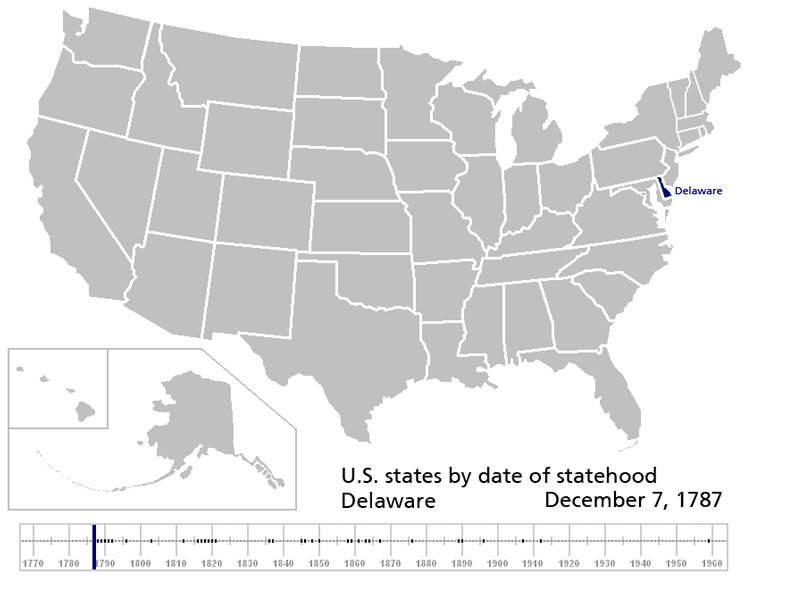
|
| Lesson Plan Manifest Destiny Definition, Summary, Facts, and History, Order of Statehood Dates |
| Manifest Destiny Map Superimposed on States |
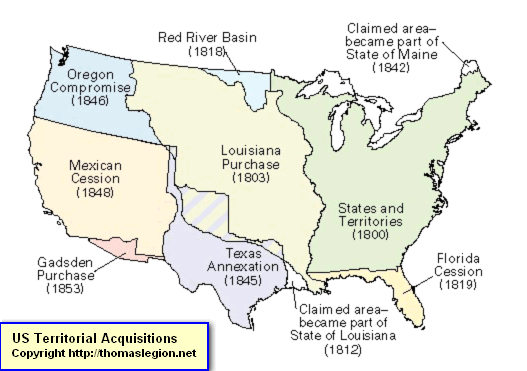
|
| Map of Manifest Destiny was the US doctrine of territorial acquisition |
Manifest Destiny Definition
Manifest Destiny was a phrase used by leaders and politicians in the 1840s
to explain continental expansion by the United States – revitalized a sense of "mission" or national destiny for Americans.
Manifest Destiny was also discussed during the Kansas-Nebraska Act.
Origin of Manifest Destiny
The term "manifest destiny" first appeared in print in July 1845 in the
"Democratic Review." Journalist John L. O'Sullivan supported the United States' claim to Texas and declared that the United States had a manifest destiny to spread across the continent.
Manifest Destiny History
The United States believed its
mission was to extend the "boundaries of freedom" to others by imparting its idealism and belief in democratic institutions
to those who were capable of self-government. It "excluded those people who were perceived as being incapable
of self-government," such as Native American people and those of non-European origin.
But there were additional forces
and political agendas at work. As the population of the original 13 Colonies grew and the U.S. economy developed, the desire and attempts to expand into new land increased. For many colonists,
land represented potential income, wealth, self-sufficiency and freedom. Expansion into the western frontiers offered opportunities
for self-advancement.
| Manifest Destiny Map for Kids. Manifest Destiny. |
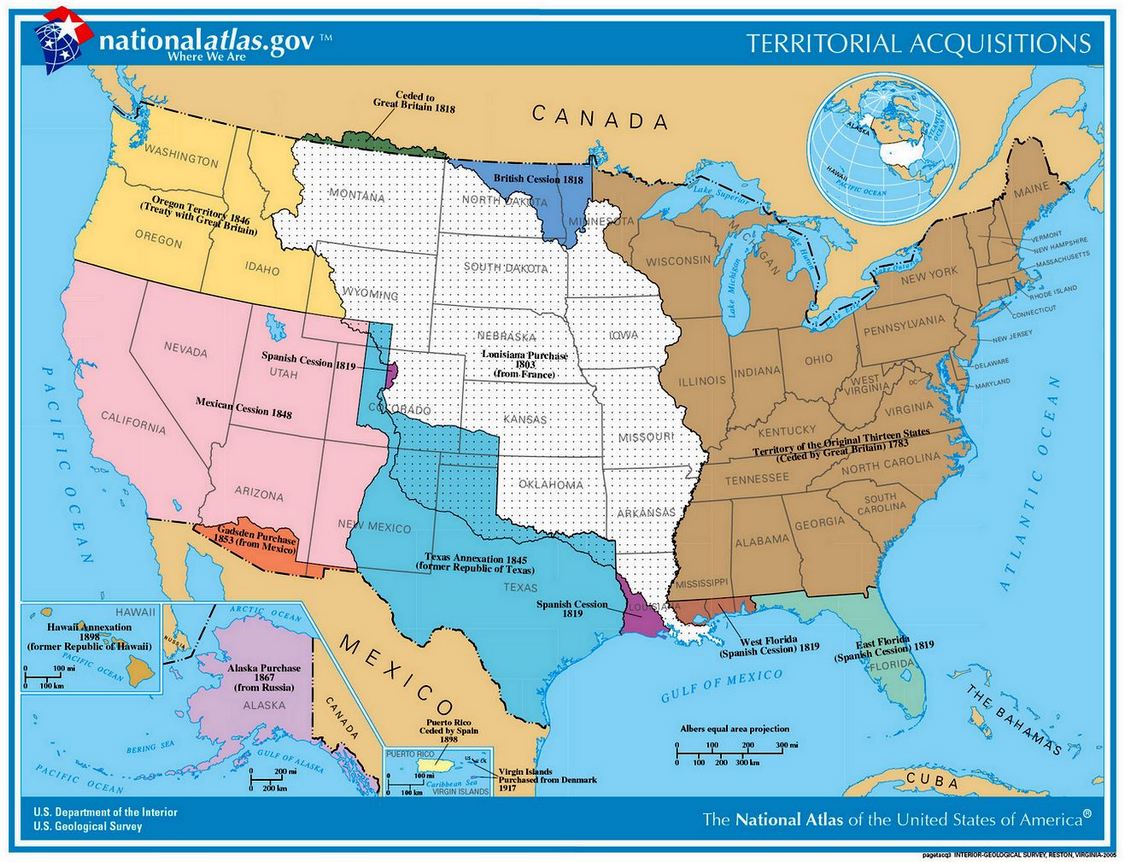
|
| Official Manifest Destiny Map shows territory and land gained by the US. Manifest Destiny Lesson Map |
| Manifest Destiny Map of States |
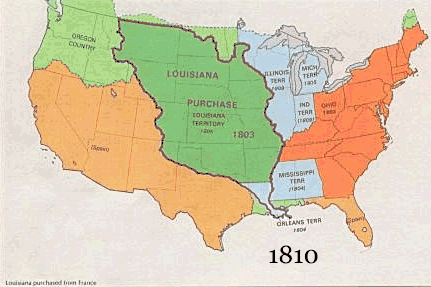
|
| Manifest Destiny and order of states admitted into the Union Map |
Manifest Destiny Facts
To understand Manifest Destiny, it's important to understand the United
States' need, desire and justification to expand. While the following points illustrate some of the economic, social and political
pressures promoting U.S. expansion, it also shows that the acquired territory came at a high price resulting in negative
consequences for many.
- The United States was experiencing a periodic high birth rate and increases
in population due to immigration. And because agriculture provided the primary economic structure, large families to work
the farms were considered an asset. The U.S. population grew from more than five million in 1800 to more than 23 million by
mid-century. Thus, there was a need to expand into new territories to accommodate this rapid growth. It's estimated that nearly
4,000,000 Americans moved to western territories between 1820 and 1850.
- The United States suffered two economic depressions — one in 1818 and
a second in 1839. These crises drove some people to seek their living in frontier areas.
- Frontier land was inexpensive or, in some cases, free.
- Expansion into frontier areas opened opportunities for new commerce and individual
self-advancement.
- Land ownership was associated with wealth and tied to self-sufficiency, political
power and independent "self-rule."
- Maritime merchants saw an opportunity to expand
and promote new commerce by building West Coast ports leading to increased trade with countries in the Pacific.
- Native Americans were nearly eradicated from the land
that they once called home. Forced onto lands that Washington believed were far enough west and too barren for any white
man to ever desire, the reservations would soon be overrun as white settlers partook in the Homestead Act and the promise of newfound dreams in an American oasis.
- Mexico lost 55% of its territory
to the United States under the doctrine of Manifest Destiny, thus forcing the defeated nation into bankruptcy and causing
its economy to be in shambles for nearly 100 years.
- American Civil War was a harsh reality of Manifest Destiny, because with the Mexican Cession in 1848, the Compromise of 1850 followed, only to fail as four free states were carved quickly from newly acquired territory causing Sectionalism and a more politically powerful North and an economically weaker South.
| Manifest Destiny Territory Growth & Expansion Map |
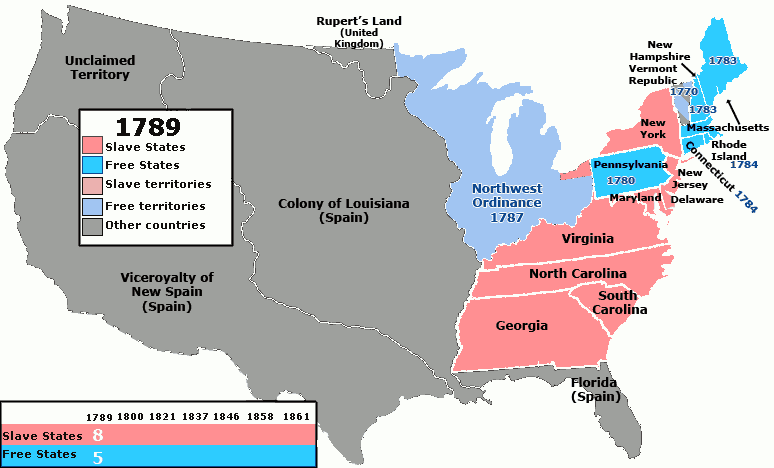
|
| Manifest Destiny and Acquisition of Territory, Lands, and US States Map |
Sources: Library of Congress; National Park Service; Department of the Interior; PBS Online; National Archives
Manifest Destiny Causes and Origins
Recommended Reading: Seizing Destiny:
The Relentless Expansion of American Territory.
From Publishers Weekly: In an admirable and important addition to his distinguished oeuvre, Pulitzer Prize–winner Kluger
(Ashes to Ashes, a history of the tobacco wars) focuses on the darker side of America's rapid expansion westward. He begins
with European settlement of the so-called New World, explaining that Britain's
successful colonization depended not so much on conquest of or friendship with the Indians, but on encouraging emigration.
Kluger then fruitfully situates the American Revolution as part of the story of expansion: the Founding Fathers based their
bid for independence on assertions about the expanse of American virgin earth and after the war that very land became the
new country's main economic resource. Continued below...
The heart of the book, not surprisingly,
covers the 19th century, lingering in detail over such well-known episodes as the Louisiana Purchase and William Seward's
acquisition of Alaska. The final chapter looks at expansion in the 20th century. Kluger provocatively suggests
that, compared with western European powers, the United States engaged
in relatively little global colonization, because the closing of the western frontier sated America's expansionist hunger. Each chapter of this long, absorbing book is rewarding
as Kluger meets the high standard set by his earlier work. Includes 10 detailed maps.
Recommended
Viewing: Lewis & Clark - The Journey
of the Corps of Discovery (1997) (DVD) (240
minutes) (PBS) (September 28, 2004). Review: Another reliably well-crafted, generally engrossing documentary from Ken Burns,
Lewis & Clark employs the director's now-familiar approach to his subjects, from its elegant juxtaposition of period illustrations
and portraits against newly filmed footage of historic sites to Burns's repertory of accomplished actors to provide gravitas
for quotes from the key figures. Granted the formula has become familiar enough to allow parody, but Burns knows how to invest
his historical investigations with movement and drama, making this four-hour journey a worthwhile trip. Continued below…
As narrated
by Hal Holbrook, Dayton Duncan's script explicates the agenda presented by Thomas Jefferson to Meriwether Lewis and William
Clark, placing it in the context of the young country's gamble in Jefferson's Louisiana Purchase, and the
expedition's goals for opening the West. While preserving the heroic scale of the undertaking, Burns also finds time to delve
into the politics of the venture and the disparate personalities of the two explorers; in particular, Duncan and Burns look
at the career of Lewis, the presidential protégé, his moody demeanor, and his untimely death. The film also looks beyond its
titular leaders to examine the personalities of their corps of soldiers, their boatmen, and the Indians they met and depended
on, most notably their female Shosone guide, Sacagawea. --Sam Sutherland
Recommended
Reading:
Manifest Destiny: American Expansion and the Empire of Right (Critical
Issue Book). From Booklist: In this concise essay, Stephanson explores the religious antecedents to America's quest to control a continent and then an empire.
He interprets the two competing definitions of destiny that sprang from the Puritans' millenarian view toward the wilderness
they settled (and natives they expelled). Here was the God-given chance to redeem the Christian world, and that sense of a
special world-historical role and opportunity has never deserted the American national self-regard. But would that role be
realized in an exemplary fashion, with America a model for liberty, or
through expansionist means to create what Jefferson called "the empire of liberty"? Continued
below…
The
antagonism bubbles in two periods Stephanson examines closely, the 1840s and 1890s. In those times, the journalists, intellectuals,
and presidents he quotes wrestled with America's purpose in fighting each decade's war,
which added territory and peoples that somehow had to be reconciled with the predestined future. …A sophisticated analysis
of American exceptionalism for ruminators on the country's purpose in the world.
Recommended Reading: What Hath God Wrought: The Transformation of America, 1815-1848 (Oxford History of the United States) (Hardcover: 928 pages). Review: The newest volume in the renowned Oxford History of the United States-- A brilliant portrait
of an era that saw dramatic transformations in American life The Oxford History of the United States is by far the most respected multi-volume history of our nation.
The series includes two Pulitzer Prize winners, two New York Times bestsellers, and winners of the Bancroft and Parkman Prizes.
Now, in What Hath God Wrought, historian Daniel Walker Howe illuminates the period from the battle of New
Orleans to the end of the Mexican-American War, an era when the United
States expanded to the Pacific and won control over the richest part of the North American
continent. Continued below…
Howe's panoramic
narrative portrays revolutionary improvements in transportation and communications that accelerated the extension of the American
empire. Railroads, canals, newspapers, and the telegraph dramatically lowered travel times and spurred the spread of information.
These innovations prompted the emergence of mass political parties and stimulated America's economic development from
an overwhelmingly rural country to a diversified economy in which commerce and industry took their place alongside agriculture.
In his story, the author weaves together political and military events with social, economic, and cultural history. He examines
the rise of Andrew Jackson and his Democratic party, but contends that John Quincy Adams and other Whigs--advocates of public
education and economic integration, defenders of the rights of Indians, women, and African-Americans--were the true prophets
of America's future. He reveals the power
of religion to shape many aspects of American life during this period, including slavery and antislavery, women's rights and
other reform movements, politics, education, and literature. Howe's story of American expansion -- Manifest Destiny -- culminates
in the bitterly controversial but brilliantly executed war waged against Mexico
to gain California and Texas for the United States. By 1848, America
had been transformed. What Hath God Wrought provides a monumental narrative of this formative period in United States history.
Recommended Reading:
The Impending Crisis, 1848-1861
(Paperback), by David M. Potter. Review: Professor
Potter treats an incredibly complicated and misinterpreted time period with unparalleled objectivity and insight. Potter masterfully
explains the climatic events that led to Southern secession – a greatly divided nation – and the Civil War: the social, political
and ideological conflicts; culture; American expansionism, sectionalism and popular sovereignty; economic and tariff
systems; and slavery. In other words, Potter places under the microscope the root causes
and origins of the Civil War. He conveys the subjects in easy to understand language to edify the reader's
understanding (it's not like reading some dry old history book). Delving
beyond surface meanings and interpretations, this book analyzes not only the history, but the historiography of the time period
as well. Continued below…
Professor Potter
rejects the historian's tendency to review the period with all the benefits of hindsight. He simply traces the events, allowing
the reader a step-by-step walk through time, the various views, and contemplates the interpretations of contemporaries and
other historians. Potter then moves forward with his analysis. The Impending Crisis is the absolute gold-standard of historical
writing… This simply is the book by which, not only other antebellum era books, but all history books should be judged.
Recommended Reading: Manifest Destiny and
Mission in American History (Harvard
University Press). Description: "Before this book first appeared in 1963,
most historians wrote as if the continental expansion of the United States
was inevitable. 'What is most impressive,' Henry Steele Commager and Richard Morris declared in 1956, 'is the ease, the simplicity,
and seeming inevitability of the whole process.' Continued below...
The notion of 'inevitability,' however, is perhaps only a secular variation
on the theme of the expansionist editor John L. O'Sullivan, who in 1845 coined one of the most famous phrases in American
history when he wrote of 'our manifest destiny to overspread the continent allotted by Providence for the free development of our yearly multiplying
millions.' Frederick Merk rejected inevitability in favor of a more contingent interpretation of American expansionism in
the 1840s. As his student Henry May later recalled, Merk 'loved to get the facts straight.'"
--From the Foreword by John Mack Faragher About the Author: Frederick Merk was Gurney Professor of American History,
Harvard University.
Recommended Reading:
Slavery and the American West: The Eclipse of Manifest Destiny. Description: Tracing the “sectionalization”
of American politics in the 1840s and 1850s, Michael Morrison offers a comprehensive study of how slavery and territorial
expansion intersected as causes of the Civil War. Specifically, he argues that the common heritage of the American Revolution
bound Americans together until disputes over the extension of slavery into the territories led northerners and southerners
to increasingly divergent understandings of the Revolution's legacy. Manifest Destiny promised the literal enlargement of
freedom through the extension of American institutions all the way to the Pacific. Continued below…
At each step—from John Tyler's
attempt to annex Texas in 1844, to the Kansas-Nebraska Act, to the opening shots of the Civil War—the
issue of slavery had to be confronted. Morrison shows that the Revolution was the common prism through which northerners and
southerners viewed these events and that the factor that ultimately made consensus impossible was slavery itself. By 1861,
no nationally accepted solution to the dilemma of slavery in the territories had emerged, no political party existed as a
national entity, and politicians from both North and South had come to believe that those on the other side had subverted
the American political tradition.
|

